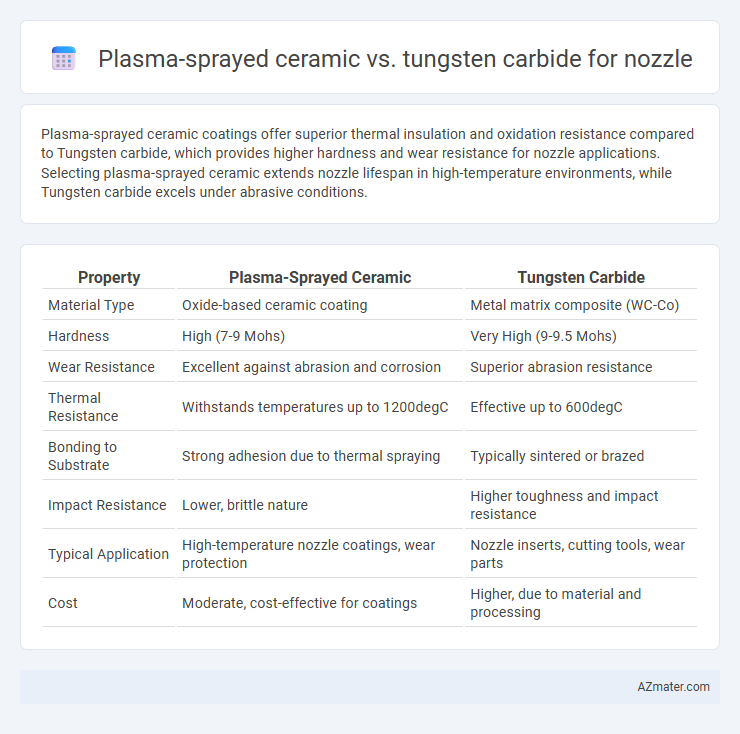Plasma-sprayed ceramic coatings offer superior thermal insulation and oxidation resistance compared to Tungsten carbide, which provides higher hardness and wear resistance for nozzle applications. Selecting plasma-sprayed ceramic extends nozzle lifespan in high-temperature environments, while Tungsten carbide excels under abrasive conditions.
Table of Comparison
| Property | Plasma-Sprayed Ceramic | Tungsten Carbide |
|---|---|---|
| Material Type | Oxide-based ceramic coating | Metal matrix composite (WC-Co) |
| Hardness | High (7-9 Mohs) | Very High (9-9.5 Mohs) |
| Wear Resistance | Excellent against abrasion and corrosion | Superior abrasion resistance |
| Thermal Resistance | Withstands temperatures up to 1200degC | Effective up to 600degC |
| Bonding to Substrate | Strong adhesion due to thermal spraying | Typically sintered or brazed |
| Impact Resistance | Lower, brittle nature | Higher toughness and impact resistance |
| Typical Application | High-temperature nozzle coatings, wear protection | Nozzle inserts, cutting tools, wear parts |
| Cost | Moderate, cost-effective for coatings | Higher, due to material and processing |
Introduction to Nozzle Materials: Ceramic vs Tungsten Carbide
Plasma-sprayed ceramic coatings provide exceptional thermal resistance and wear protection, making them ideal for high-temperature nozzle environments. Tungsten carbide offers superior hardness and abrasion resistance, ensuring durability under intense mechanical stress. Selecting between ceramic and tungsten carbide depends on balancing thermal insulation needs with mechanical strength requirements in nozzle applications.
Plasma-Sprayed Ceramic Nozzle Overview
Plasma-sprayed ceramic nozzles offer superior thermal resistance and corrosion protection compared to tungsten carbide, making them ideal for high-temperature and abrasive environments in industrial applications. These ceramic coatings provide excellent wear resistance and maintain structural integrity under extreme conditions, extending nozzle lifespan and reducing maintenance costs. Unlike tungsten carbide, plasma-sprayed ceramics deliver enhanced insulation and lower thermal conductivity, improving overall nozzle performance in processes such as thermal spraying and fluid handling.
Tungsten Carbide Nozzle Properties
Tungsten carbide nozzles exhibit exceptional hardness and wear resistance, making them ideal for high-abrasion environments and extending nozzle lifespan compared to plasma-sprayed ceramic coatings. Their superior thermal conductivity supports efficient heat dissipation, preventing deformation under extreme operating temperatures. Furthermore, tungsten carbide's strong bond strength ensures resistance to impact and erosion, providing reliable performance in demanding industrial applications.
Wear Resistance: Ceramic vs Tungsten Carbide
Plasma-sprayed ceramic coatings offer superior wear resistance compared to tungsten carbide in nozzle applications, primarily due to their high hardness and thermal stability. Ceramic materials, such as alumina or zirconia, exhibit enhanced resistance to abrasion and corrosion, extending nozzle lifespan under extreme conditions. Tungsten carbide provides good toughness but tends to wear faster in high-temperature, erosive environments compared to plasma-sprayed ceramics.
Corrosion and Chemical Resistance Comparison
Plasma-sprayed ceramic coatings exhibit superior corrosion resistance due to their inert oxide compositions, effectively protecting nozzles from acidic and oxidative environments. Tungsten carbide, while offering excellent hardness and wear resistance, tends to be more susceptible to chemical attack and corrosion, especially in acidic or high-temperature conditions. The enhanced chemical stability of plasma-sprayed ceramics makes them ideal for nozzles exposed to aggressive corrosive agents.
Thermal Stability in Nozzle Applications
Plasma-sprayed ceramic coatings exhibit superior thermal stability in nozzle applications, maintaining structural integrity at temperatures exceeding 1500degC, which significantly reduces thermal erosion and oxidation. Tungsten carbide, while offering excellent hardness and wear resistance, typically withstands temperatures only up to about 900degC before degradation occurs. The high melting point and low thermal conductivity of plasma-sprayed ceramics enhance nozzle lifespan in high-temperature environments compared to tungsten carbide-based materials.
Cost Analysis: Ceramic vs Tungsten Carbide Nozzles
Plasma-sprayed ceramic nozzles generally offer lower initial manufacturing costs compared to tungsten carbide nozzles due to less expensive raw materials and simpler production processes. However, tungsten carbide nozzles provide superior wear resistance and longer service life, reducing replacement frequency and lowering long-term operational expenses. Evaluating total cost of ownership shows tungsten carbide may be more cost-effective in high-abrasion applications despite higher upfront investment.
Maintenance and Service Life Considerations
Plasma-sprayed ceramic nozzles offer superior wear resistance and thermal insulation, significantly reducing maintenance frequency compared to tungsten carbide counterparts. Tungsten carbide, while highly durable against mechanical abrasion, requires more frequent inspections and repairs due to thermal degradation under high-temperature conditions. Selecting plasma-sprayed ceramic extends service life in high-temperature applications, lowering downtime and operational costs.
Application Suitability: Which Material Fits Best?
Plasma-sprayed ceramic coatings offer superior thermal resistance and oxidation protection, making them ideal for high-temperature nozzle applications in aerospace and combustion engines. Tungsten carbide, known for its exceptional hardness and wear resistance, excels in abrasive environments such as sandblasting or fuel injector nozzles exposed to particulate erosion. Choosing the right material depends on whether thermal insulation or mechanical durability against erosion is the primary requirement for the nozzle's operational environment.
Conclusion: Choosing the Optimal Nozzle Material
Plasma-sprayed ceramic nozzles offer superior thermal resistance and corrosion protection, making them ideal for high-temperature and abrasive environments. Tungsten carbide nozzles provide exceptional hardness and wear resistance, excelling in applications requiring durability against mechanical erosion. Selecting the optimal nozzle material depends on balancing thermal endurance and mechanical wear requirements specific to the operational context.

Infographic: Plasma-sprayed ceramic vs Tungsten carbide for Nozzle
 azmater.com
azmater.com